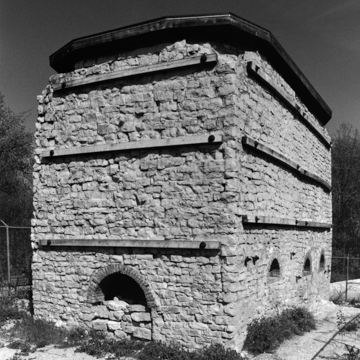Scattered lime kilns survive in Waukesha County, reminding us of a once-thriving industry. A limestone quarry opened here in 1838, and lime production began soon after. Workers heated limestone to about 900 degrees, yielding a powdery calcium-oxide residue, which they then mixed with sand and water to make mortar for masonry buildings. Vertical-shaft kilns were common to commercial operations, since they could be loaded, burned, and drawn continuously. Workers shoveled limestone into the shafts at the tops of the kilns and lit fireboxes of cordwood set into the walls. Once the firing was finished, the workers removed the lime through the drawholes.
These three rectangular kilns built by Mace are made of rough limestone blocks and have two round vertical shafts lined with firebrick below and iron rings toward the top. Round-arched drawholes (reconstructed in brick for stabilization) pierce the bottom of each structure on all sides. The horizontal bands of wood have been added to stabilize the structure, and a rubber membrane over the top keeps water out.


